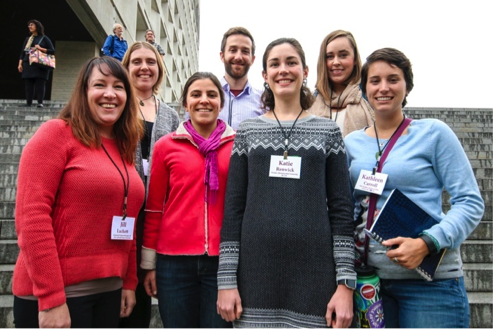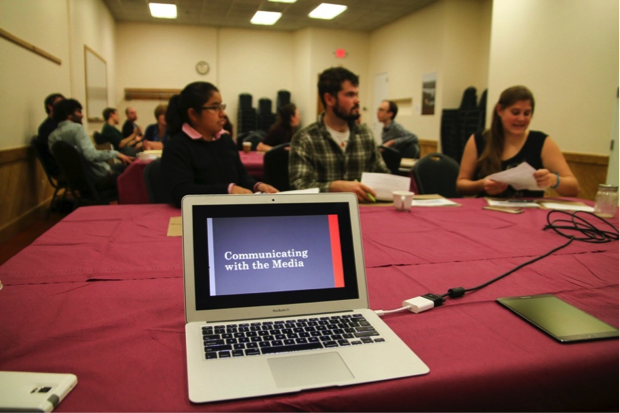
Our Role in Improving Media Coverage of Science
By Lindsey Middleton
Last fall, I set out to organize my first workshop—Communicating with the Media, a one-hour interactive talk for climate science graduate students, post-docs, and early career researchers at a national Climate Science Center (CSC) training in Amherst, MA. Building the workshop, talking to workshop participants and brainstorming with my fellow facilitators got me thinking—how can researchers and science communicators improve the media’s representation of science?

To plan for the workshop, I pulled example after example of bad science media, planned a couple anecdotes of my own less-than-stellar experiences with local media outlets, and laid out a few guiding principles to convince the early-career scientists to think about their work like a reporter would, so they’d be better prepared for interviews. Tempered by my co-presenters, we added in some positive notes—here’s why talking to the media is important, something I had neglected to include—and pulled some examples of good science media coverage.
Our examples included this compelling New York Times article and video (a great example of accurate and meaningful science reporting) and on the flipside, this and this and this article from nationally and globally recognized news sources incorrectly interpreting a scientific paper on music cognition (which was bad enough that the authors later wrote another paper about its misinterpretation). Both the good and bad examples were intended to instill a sense of caution. It should be no surprise that the media can get it wrong, but rather than take a pessimistic perspective, we should think about why, and what can be done.
It’s important to note that science communication often falls short on both sides. Journalists face a lot of scrutiny and competition and are struggling to keep up with fundamental changes in how news gets delivered. Audiences that used to read long-form daily newspapers and listen to nightly news broadcasts are increasingly turning to short-form, attention-grabbing online news. This means an increase in controversial, high-profile, and emotion-based news stories. As a result, reporters are aren’t able to spend very much time with each topic. It’s not a great atmosphere for science news. On the other end of the spectrum, science writing, like project reports and dissertations, can be inaccessible for those not well-versed in the research. In the above “bad” reporting example, the study’s title and introductory paragraph both made an unqualified claim that reporters used to tell an incomplete story—they would have had to scroll far down to the discussion section to read the limitations of the study, and then they would have had to infer that because of those limitations, the study might not be broadly applicable. Scientists know to look for those limitations before interpreting the results, but reporters are mainly looking for a central idea most likely to draw interest and readership. (Read more about media coverage of uncertainty and risk.)

At my Communicating with the Media workshop, I came prepared to convince the participants that they should be putting in their own time and effort to narrow the science-media gap. What I didn’t count on was that I was presenting to climate scientists, a group of individuals who’d already experienced first-hand that politicians, the media, and the public lack a clear (or even a basic) understanding of their work, and who regularly see occurrences of inaccurate science portrayal in the media. I didn’t need to provide any extra motivation. That said, there’s a lot still to be done to bridge the gap between climate science and the public. And all researchers of all scientific disciplines—not just those that are flashy, controversial, and politicized—stand to gain from improved communication.
So, what can we do?
There are scientists who communicate well and are willing to spend the time and effort to make their science widely accessible. Doing so takes recognizing that it’s easy to grow accustomed to high-level ideas and terminology. There’s also a chance that non-scientific audiences (like journalists, undergrad or high school students, etc.) might be accessing and reading scientific articles with or without direct access to the author to get clarification. The skill set required to translate science into meaningful stories, and putting in the time and effort to execute that translation, is what I’ll talk a little about below. There are also resources like articles, books, and workshops for those interested in learning more.
Here are some thoughts I shared with workshop participants on how science communicators and researchers can do their part to bridge the gap.
- Communicate like a story-teller. Researchers are taught to respect the scientific method—hypothesize, develop testable predictions, experiment, rethink the process, draw conclusions, share results. That method works well, but only when the intended audience is other scientists trained in your field. Thinking more like a story-teller, and doing so from the beginning of each project, will make presentations, reports, and articles more approachable. Some questions to consider:
- Why did this research come about?
Most research fills a scientific or management need. What’s the broader goal of this type of work? - Who stands to benefit?
Defining the group that will most benefit from your work can help articulate the purpose. Ideally, science is a two-way street, so they’re probably the same people who provided the research need in the first place. For example, if you’re building a model, who’s going to use the model, and why? If you’re synthesizing data, who will use the data, and for what purpose? If you’re conducting interviews, who wants to know what those people think, and why? - What is the impact?
Story-tellers ask themselves what message they want their audience to walk away with (think about the central message you took away from your favorite book or movie). What that message is will vary. Using the two questions above, put your work into a broader context, think about why you’re doing it and for whom, and then determine the potential impact. If your study failed to turn out any significant results, its impact may be why your research question or methods were invalid and how others could improve. Think of this as your discussion/interpretation section, but expanded. Outside audiences will want to know how the project fits into other research, why that research is important, and what it means for other scientists and/or society. Thinking on that scale can also take some of the pressure off your individual project. You’re part of a broader community of scientists working toward an improved understanding of one particular topic. Thinking in those terms is a great angle to get you started on thinking like a story-teller. - Who’s your intended audience?
Keep in mind those groups of people who aren’t familiar with your work that may be building on, learning from, or telling stories about your work. Communicating for a non-scientific audience, at the most basic level, means defining terms or removing jargon altogether. At a more advanced level, it means targeting your communications so the work can be broadly understood. Politicians have a great understanding of the terminology and practices that result in Senate and House bills, and they can read those documents quickly and easily—to most of us, though, House and Senate bills are complex and confusing. That’s how non-scientists see scientific writing—complicated, technical, and tough to understand. Take a closer look at your language and ask yourself if non-technical audiences can at least understand why you’re doing what you’re doing.
- Why did this research come about?
- Remember that it’s a team effort. Reporters are trained communicators. If you’ve done your homework and thought about what to convey and how, reporters will probably do their jobs well too and tell a great story about your work.
- Recognize the limitations of the media. Because of many pressures that modern-day journalists contend with, discussed above, the story won’t be perfect, no matter how well you prepare. That’s to be expected. Attaining perfection in science news, even for the most skilled reporters, is an unrealistic task. But as an expert in your field, you can minimize misunderstandings and present your work in a useful context to help ease the way for an interesting story that portrays the basic facts accurately.
Scientists and communicators alike know that science is underrepresented and often inaccurately portrayed in the media. But journalists can be a great ally, too. They’re communicators whose goal is to connect audiences with information. Your goal as a scientist/researcher is to seek out knowledge and provide information and tools, so think of the media as extension of your work. That increases your audience to people who aren’t immediately familiar with your field, though, so keep in mind why you’re doing it and how it fits into a broader context to help reporters meet their goals of communicating relevant and impactful news stories. Maybe we can use these skills and connections to contribute to a better understanding of science among broader audiences.
Acknowledgements: Thanks to Toni Klemm and Kristen Donahue, my Communicating with the Media co-facilitators, for their input and perspectives and their efforts toward the success of the workshop.
Digging Deeper into Media Interactions—A Few Resources for Scientists
- Science Media Savvy: Tips from scientists who deal with the media regularly
- The Scripps Research Institute: 10 Tips for Scientists on Talking to the Media
- Science Magazine: Your Research in the Headlines: Dealing with the Media
- The American Association for the Advancement of Science: Tips for Scientists Communicating with the Press
- Southern Fried Science: The Importance of Word Choice: Terms with multiple meanings for scientists and the public
- A Scientist’s Guide to Talking with the Media
- By author Randy Olson: Don’t be Such a Scientist and the follow-up, Houston, We Have a Narrative
Lindsey Middleton is a Communications Specialist at the North Central Climate Science Center, a regional research organization that focuses on climate drivers, ecological impacts, and adaptation.
Connect with EcoPress on social media, like us on Facebook and follow us on Twitter, @nrel_science, for the more stories and news.